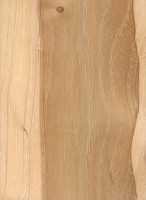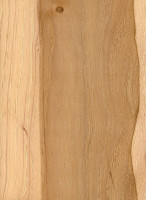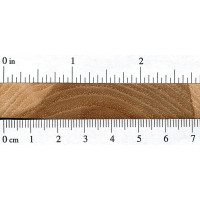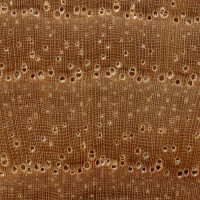 |
Common Name(s): Pecan Scientific Name: Carya illinoinensis Distribution: South-central United States and Mexico Tree Size: 100-130 ft (30-40 m) tall, 2-4 ft (.6-1.2 m) trunk diameter Average Dried Weight: 46 lbs/ft3 (735 kg/m3) Specific Gravity (Basic, 12% MC): .60, .74 Janka Hardness: 1,820 lbf (8,100 N) Modulus of Rupture: 13,700 lbf/in2 (94.5 MPa) Elastic Modulus: 1,730,000 lbf/in2 (11.93 GPa) Crushing Strength: 7,850 lbf/in2 (54.1 MPa) Shrinkage: Radial: 4.9%, Tangential: 8.9%, Volumetric: 13.6%, T/R Ratio: 1.8 |
Color/Appearance: Heartwood tends to be light to medium brown, with a reddish hue; sapwood is a paler yellowish brown.
Grain/Texture: Grain is usually straight, though occasionally wavy. Texture is medium, with a low natural luster.
Endgrain: Ring-porous to semi-ring-porous; large to very large earlywood pores in a single intermittent row, medium to small latewood pores solitary and radial multiples of 2-3, few; tyloses common; parenchyma reticulate (bands absent from earlywood row in true hickory group, but present in pecan hickory group); narrow rays, close spacing.
Rot Resistance: Considered to be non-durable to perishable regarding heartwood decay, and also very susceptible to insect attack.
Workability: Difficult to work, with tearout being common during machining operations if cutting edges are not kept sharp; the wood tends to blunt cutting edges. Glues, stains, and finishes well. Responds well to steam bending.
Odor: No characteristic odor.
Allergies/Toxicity: Besides the standard health risks associated with any type of wood dust, no further health reactions have been associated with Pecan. See the articles Wood Allergies and Toxicity and Wood Dust Safety for more information.
Pricing/Availability: Various species of Hickory and Pecan (Carya genus) are typically mixed together and simply sold as Hickory. Prices are usually in the low to mid range, depending upon local availability. Hickory prices should compare similarly to other utility hardwoods such as Red Oak or Soft Maple.
Sustainability: This wood species is not listed in the CITES Appendices or on the IUCN Red List of Threatened Species.
Common Uses: Tool handles, ladder rungs, wheel spokes, and flooring.
Comments: Pecan has slightly lower strength values than some of the other species of Hickory, but it is still among the hardest and strongest of woods native to the United States. The wood is commonly used where strength or shock-resistance is important. As the common name implies, Carya illinoinensis is the tree responsible for producing Pecan nuts commonly used in snacks and cooking recipes, and is the state tree of Texas.
Pecan falls into the Pecan-Hickory grouping, which tends to be slightly stabler but weaker than the True-Hickories, and is considered to be a semi-ring-porous wood. The strength characteristics of Pecan are somewhat influenced by the spacing of its growth rings. In general, wood from faster-growing trees, with wider spaced growth rings, tends to be harder, heavier, and stronger than wood from slower-growing trees that have rings which are closer together.
In addition to strength and hardness applications, the wood of Carya species also has a very high thermal energy content when burned, and is sometimes used as fuelwood for wood stoves. Additionally, Pecan is also used as charcoal in cooking meat, with the smoke imparting additional flavor to the food.








Hi! I am a relatively new woodworker and came accoss a pecan board with some beautiful grain. I am considering making it into a single piece cutting board. Does anyone know if pecan wood can be used for cutting boards? As a hardwood, it seems like this would work well.
Yes is a good hardwood to use for a cutting board. We made butcher block counters from pecan.
Have noticed recently when working with pecan sourced locally (just south of Hill Country Texas, around San Antonio) i have begun to get a skin irritation and respiratory irritation (makes nose run only) that makes me itch similar to the trype of itching when working around fiberglass insulation. Washing the area with soap and water cures this.
It sounds like your allergic to that specific wood, my wife has a tough time around specific woods as well
I make benches, coffee tables and oversize chairs with pecan. It mills easy on my sawmill.
Hi I’m getting ready to refinish a pecan cupboard. I’m looking for stain color suggestions. I’d like something rich and warm. Not light like oak and not dark like mahogany. Any suggestions? Thank you in advance.
Tammy, if it is natural (currently unstained) and you need to strip it of its current finish ( to stain or dye it) consider Osmo Polyx-Oil, 3031 Clear Matte finish. I suggest this as I have used it on a variety of customer projects in maple, hickory and mahogany. The finish is beautiful, easy to apply and very durable. Check it out on YouTube.
If you want rich and warm then boiled linseed oil, plus a clearcoat would be my choice. BLO and shellac are pretty much the only finishes I use these days.
Boiled linseed oil is an awesome choice, but something to be mindful of, is that it does have the ability of spontaneous combustion, so leaving rags in a pile can cause a fire, I use to stick the rags in a water filled coffee can to avoid that.
Since I began wood working and carving I have found that people seem to generally ignore or stay away from the use of Pecan in their projects. I, on the other hand, have used it in many projects due to its abundance here in South Louisiana and find it to be not only beautiful, but pretty easy to work with. I mainly use it for spoon carving, but have made other things with it as well. The only real issue that I have had is that it is very prone to splitting. Thanks for all of the info on various… Read more »
How do you treat the wood before shaping it?
I typically do not do anything special in terms of treating it. I have wrapped it in plastic and put it in the freezer on occasion to kill or prevent insects, but it is so abundant here that I usually get it and work it within a short time. It is super succeptible to insect attack so it is tough to just leave it hanging around without being tunneled through.
Hello guy’s I use rubbing alcohol to kill insects in my wood if they don’t back out of the wood they die this is the best way to make sure the insects and completely out of your wood. As I work with all types of wood curly maple or tiger maple, cedar oak elm pecan gum locus persimmon wormy maple I make rustic furniture and all sorts of stuff out of North Carolina.
I just bought some Ambrosia Maple (wormy maple) that has been air-dried. I’m afraid to bring it in my basement to store with my other wood. Do you just spray each entire board with rubbing alcohol, or what is your process? Thanks!
Wondering the same thing
I have a very, very large pecan tree for sale. It is still in the ground, located in central Maryland. Jglowe@verizon.net
I found Pecan to be a a bit fickle to work with. It burns really easily so you have to work pretty quickly to keep burning from happening. Other than that it was pretty much like working with oak. Keep the router speeds up to avoid tear out and move quickly to avoid burning.
I got a bunch of thinner boards of this from someones flooring they wanted to pull out. It is very nice but you need new or sharpened blades to work with it without burning it. It is very hard compared to many other common woods and does not dent or scratch easily, I used it around the base of my wood stove platform where it gets kicked and banged. Not a mark on it yet.
Will chunk off little pieces easily if you aren’t careful routing the corners.
Lee,
The faster growing trees tend to be stronger only with species that are ring-porous like ash, oak, etc. because the big earlywood pores are much weaker than the latewood section, so the faster it grows, the more latewood (as compared to the earlywood) there is.
In general though, especially with softwoods and most diffuse-porous hardwoods, the slower growing trees produce the strongest wood.
Hi Eric ,
Lee again from rockler and I have aquestion for you.I was looking at Pecan on the data base and you mentioned that the faster growing trees with wider growth rings were harder and stronger than the slower growing trees with narrow bands are. I always thought the opposite to be true. Any idea of why that is ? Also, is the same thing applicable to other species of wood.In making bows strength is very important.
Thanks,Lee
The growth rings are voids —where sap travels. The closer together they are, the greater concentration of voids. You can more easily break a length of slow-growth wood than fast-growth wood. I think this is called brackish wood. Learned this from The Woodwright’s Shop.